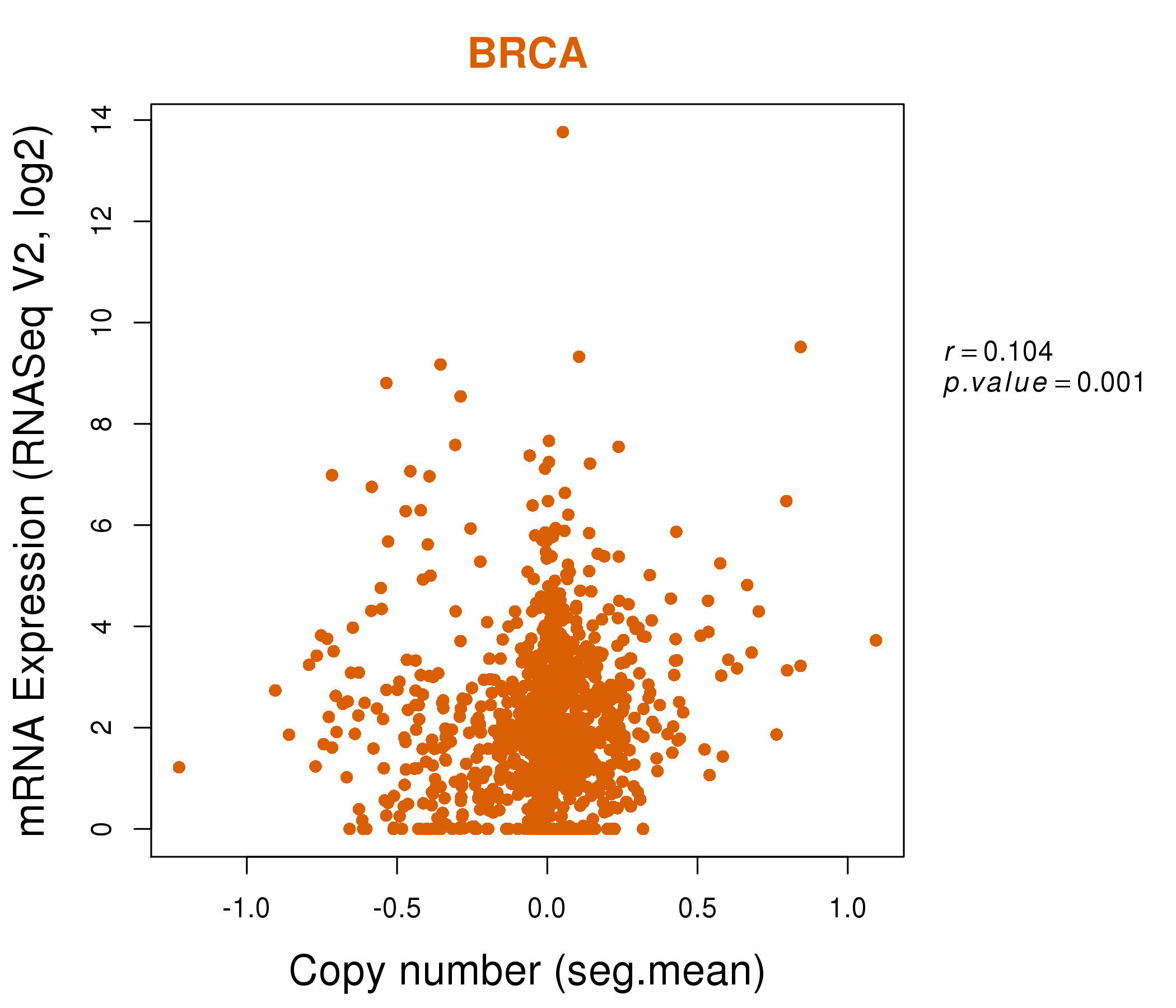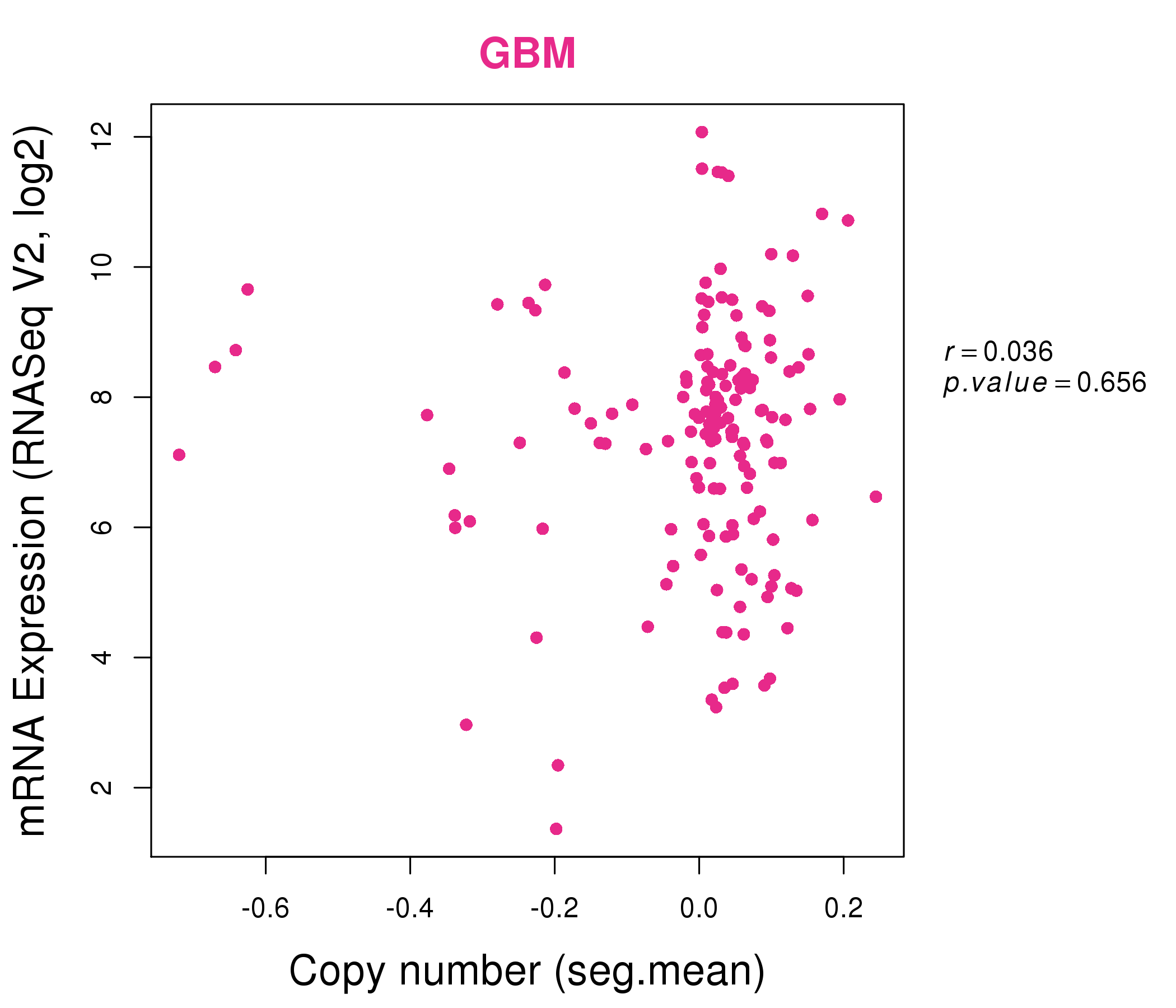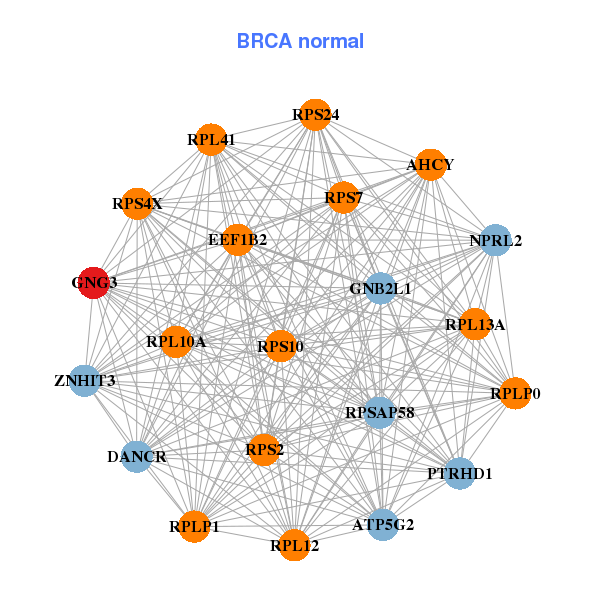|
||||||||||||||||||||
| |
| Phenotypic Information (metabolism pathway, cancer, disease, phenome) |
| |
| |
| Gene-Gene Network Information: Co-Expression Network, Interacting Genes & KEGG |
| |
|
| Gene Summary for GNG3 |
| Basic gene info. | Gene symbol | GNG3 |
| Gene name | guanine nucleotide binding protein (G protein), gamma 3 | |
| Synonyms | - | |
| Cytomap | UCSC genome browser: 11p11 | |
| Genomic location | chr11 :62475065-62476678 | |
| Type of gene | protein-coding | |
| RefGenes | NM_012202.4, | |
| Ensembl id | ENSG00000162188 | |
| Description | NBP gamma-3guanine nucleotide-binding protein G(I)/G(S)/G(O) subunit gamma-3guanine nucleotide-binding protein gamma-3 subunit | |
| Modification date | 20141207 | |
| dbXrefs | MIM : 608941 | |
| HGNC : HGNC | ||
| Ensembl : ENSG00000162188 | ||
| HPRD : 12337 | ||
| Vega : OTTHUMG00000167560 | ||
| Protein | UniProt: go to UniProt's Cross Reference DB Table | |
| Expression | CleanEX: HS_GNG3 | |
| BioGPS: 2785 | ||
| Gene Expression Atlas: ENSG00000162188 | ||
| The Human Protein Atlas: ENSG00000162188 | ||
| Pathway | NCI Pathway Interaction Database: GNG3 | |
| KEGG: GNG3 | ||
| REACTOME: GNG3 | ||
| ConsensusPathDB | ||
| Pathway Commons: GNG3 | ||
| Metabolism | MetaCyc: GNG3 | |
| HUMANCyc: GNG3 | ||
| Regulation | Ensembl's Regulation: ENSG00000162188 | |
| miRBase: chr11 :62,475,065-62,476,678 | ||
| TargetScan: NM_012202 | ||
| cisRED: ENSG00000162188 | ||
| Context | iHOP: GNG3 | |
| cancer metabolism search in PubMed: GNG3 | ||
| UCL Cancer Institute: GNG3 | ||
| Assigned class in ccmGDB | C | |
| Top |
| Phenotypic Information for GNG3(metabolism pathway, cancer, disease, phenome) |
| Cancer | CGAP: GNG3 |
| Familial Cancer Database: GNG3 | |
| * This gene is included in those cancer gene databases. |
|
|
|
|
|
| . | ||||||||||||||
Oncogene 1 | Significant driver gene in | |||||||||||||||||||
| cf) number; DB name 1 Oncogene; http://nar.oxfordjournals.org/content/35/suppl_1/D721.long, 2 Tumor Suppressor gene; https://bioinfo.uth.edu/TSGene/, 3 Cancer Gene Census; http://www.nature.com/nrc/journal/v4/n3/abs/nrc1299.html, 4 CancerGenes; http://nar.oxfordjournals.org/content/35/suppl_1/D721.long, 5 Network of Cancer Gene; http://ncg.kcl.ac.uk/index.php, 1Therapeutic Vulnerabilities in Cancer; http://cbio.mskcc.org/cancergenomics/statius/ |
| REACTOME_INTEGRATION_OF_ENERGY_METABOLISM | |
| OMIM | |
| Orphanet | |
| Disease | KEGG Disease: GNG3 |
| MedGen: GNG3 (Human Medical Genetics with Condition) | |
| ClinVar: GNG3 | |
| Phenotype | MGI: GNG3 (International Mouse Phenotyping Consortium) |
| PhenomicDB: GNG3 | |
| Mutations for GNG3 |
| * Under tables are showing count per each tissue to give us broad intuition about tissue specific mutation patterns.You can go to the detailed page for each mutation database's web site. |
| There's no structural variation information in COSMIC data for this gene. |
| * From mRNA Sanger sequences, Chitars2.0 arranged chimeric transcripts. This table shows GNG3 related fusion information. |
| ID | Head Gene | Tail Gene | Accession | Gene_a | qStart_a | qEnd_a | Chromosome_a | tStart_a | tEnd_a | Gene_a | qStart_a | qEnd_a | Chromosome_a | tStart_a | tEnd_a |
| Top |
| There's no copy number variation information in COSMIC data for this gene. |
| Top |
|
 |
| Top |
| Stat. for Non-Synonymous SNVs (# total SNVs=6) | (# total SNVs=1) |
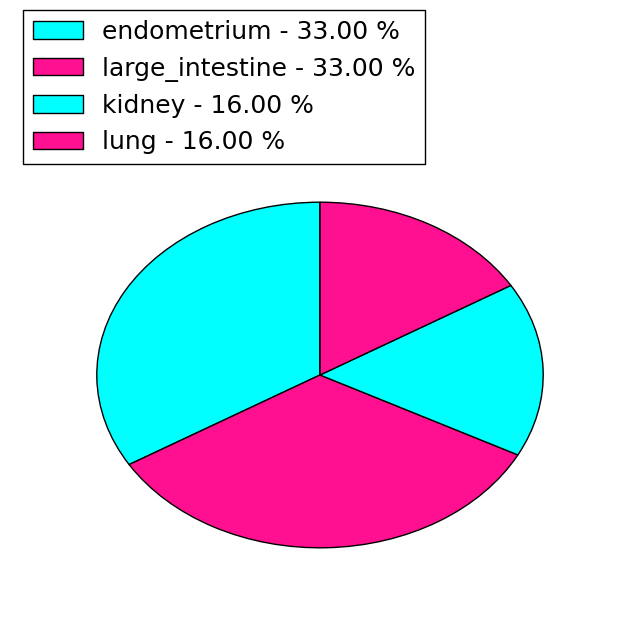 | 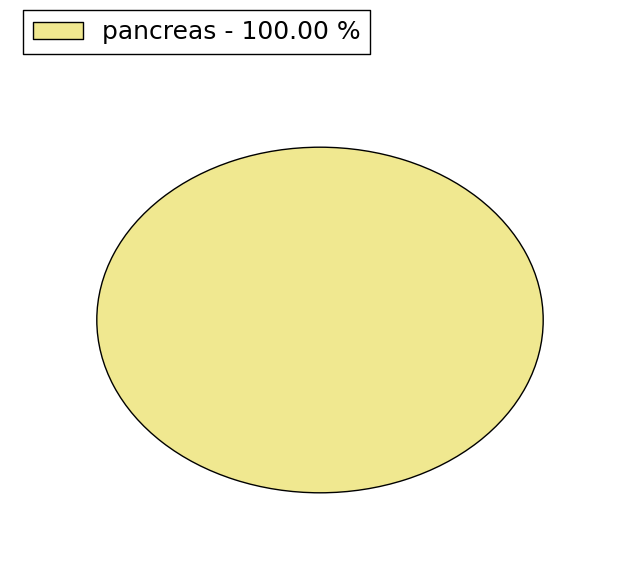 |
(# total SNVs=0) | (# total SNVs=0) |
| Top |
| * When you move the cursor on each content, you can see more deailed mutation information on the Tooltip. Those are primary_site,primary_histology,mutation(aa),pubmedID. |
| GRCh37 position | Mutation(aa) | Unique sampleID count |
| chr11:62476260-62476260 | p.F70L | 3 |
| chr11:62476263-62476263 | p.F71F | 1 |
| chr11:62476277-62476278 | p.? | 1 |
| chr11:62475816-62475816 | p.R17C | 1 |
| chr11:62475817-62475817 | p.R17H | 1 |
| chr11:62475843-62475843 | p.E26* | 1 |
| chr11:62475847-62475847 | p.A27G | 1 |
| chr11:62476150-62476150 | p.V34L | 1 |
| chr11:62476203-62476203 | p.E51E | 1 |
| chr11:62476249-62476249 | p.E67* | 1 |
| Top |
|
 |
| Point Mutation/ Tissue ID | 1 | 2 | 3 | 4 | 5 | 6 | 7 | 8 | 9 | 10 | 11 | 12 | 13 | 14 | 15 | 16 | 17 | 18 | 19 | 20 |
| # sample | 2 | 3 | 1 | 2 | 2 | |||||||||||||||
| # mutation | 2 | 3 | 1 | 2 | 1 | |||||||||||||||
| nonsynonymous SNV | 2 | 3 | 1 | 1 | 1 | |||||||||||||||
| synonymous SNV | 1 |
| cf) Tissue ID; Tissue type (1; BLCA[Bladder Urothelial Carcinoma], 2; BRCA[Breast invasive carcinoma], 3; CESC[Cervical squamous cell carcinoma and endocervical adenocarcinoma], 4; COAD[Colon adenocarcinoma], 5; GBM[Glioblastoma multiforme], 6; Glioma Low Grade, 7; HNSC[Head and Neck squamous cell carcinoma], 8; KICH[Kidney Chromophobe], 9; KIRC[Kidney renal clear cell carcinoma], 10; KIRP[Kidney renal papillary cell carcinoma], 11; LAML[Acute Myeloid Leukemia], 12; LUAD[Lung adenocarcinoma], 13; LUSC[Lung squamous cell carcinoma], 14; OV[Ovarian serous cystadenocarcinoma ], 15; PAAD[Pancreatic adenocarcinoma], 16; PRAD[Prostate adenocarcinoma], 17; SKCM[Skin Cutaneous Melanoma], 18:STAD[Stomach adenocarcinoma], 19:THCA[Thyroid carcinoma], 20:UCEC[Uterine Corpus Endometrial Carcinoma]) |
| Top |
| * We represented just top 10 SNVs. When you move the cursor on each content, you can see more deailed mutation information on the Tooltip. Those are primary_site, primary_histology, mutation(aa), pubmedID. |
| Genomic Position | Mutation(aa) | Unique sampleID count |
| chr11:62476260 | p.F70L | 3 |
| chr11:62475784 | p.P6Q | 1 |
| chr11:62475816 | p.R17C | 1 |
| chr11:62475821 | p.K18N | 1 |
| chr11:62475847 | p.A27G | 1 |
| chr11:62476150 | p.V34L | 1 |
| chr11:62476263 | p.F71F | 1 |
| chr11:62476265 | p.C72S | 1 |
| * Copy number data were extracted from TCGA using R package TCGA-Assembler. The URLs of all public data files on TCGA DCC data server were gathered on Jan-05-2015. Function ProcessCNAData in TCGA-Assembler package was used to obtain gene-level copy number value which is calculated as the average copy number of the genomic region of a gene. |
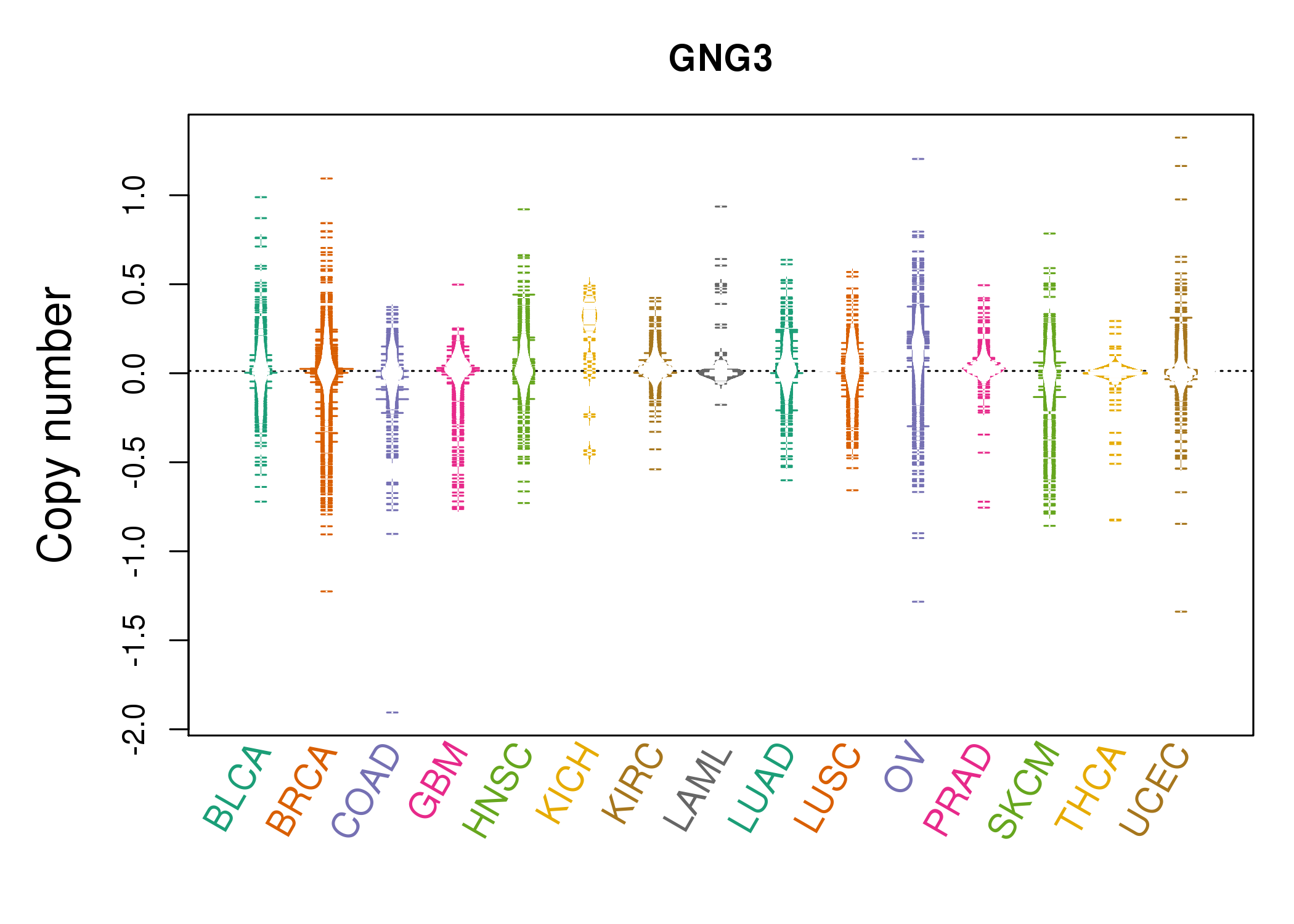 |
| cf) Tissue ID[Tissue type]: BLCA[Bladder Urothelial Carcinoma], BRCA[Breast invasive carcinoma], CESC[Cervical squamous cell carcinoma and endocervical adenocarcinoma], COAD[Colon adenocarcinoma], GBM[Glioblastoma multiforme], Glioma Low Grade, HNSC[Head and Neck squamous cell carcinoma], KICH[Kidney Chromophobe], KIRC[Kidney renal clear cell carcinoma], KIRP[Kidney renal papillary cell carcinoma], LAML[Acute Myeloid Leukemia], LUAD[Lung adenocarcinoma], LUSC[Lung squamous cell carcinoma], OV[Ovarian serous cystadenocarcinoma ], PAAD[Pancreatic adenocarcinoma], PRAD[Prostate adenocarcinoma], SKCM[Skin Cutaneous Melanoma], STAD[Stomach adenocarcinoma], THCA[Thyroid carcinoma], UCEC[Uterine Corpus Endometrial Carcinoma] |
| Top |
| Gene Expression for GNG3 |
| * CCLE gene expression data were extracted from CCLE_Expression_Entrez_2012-10-18.res: Gene-centric RMA-normalized mRNA expression data. |
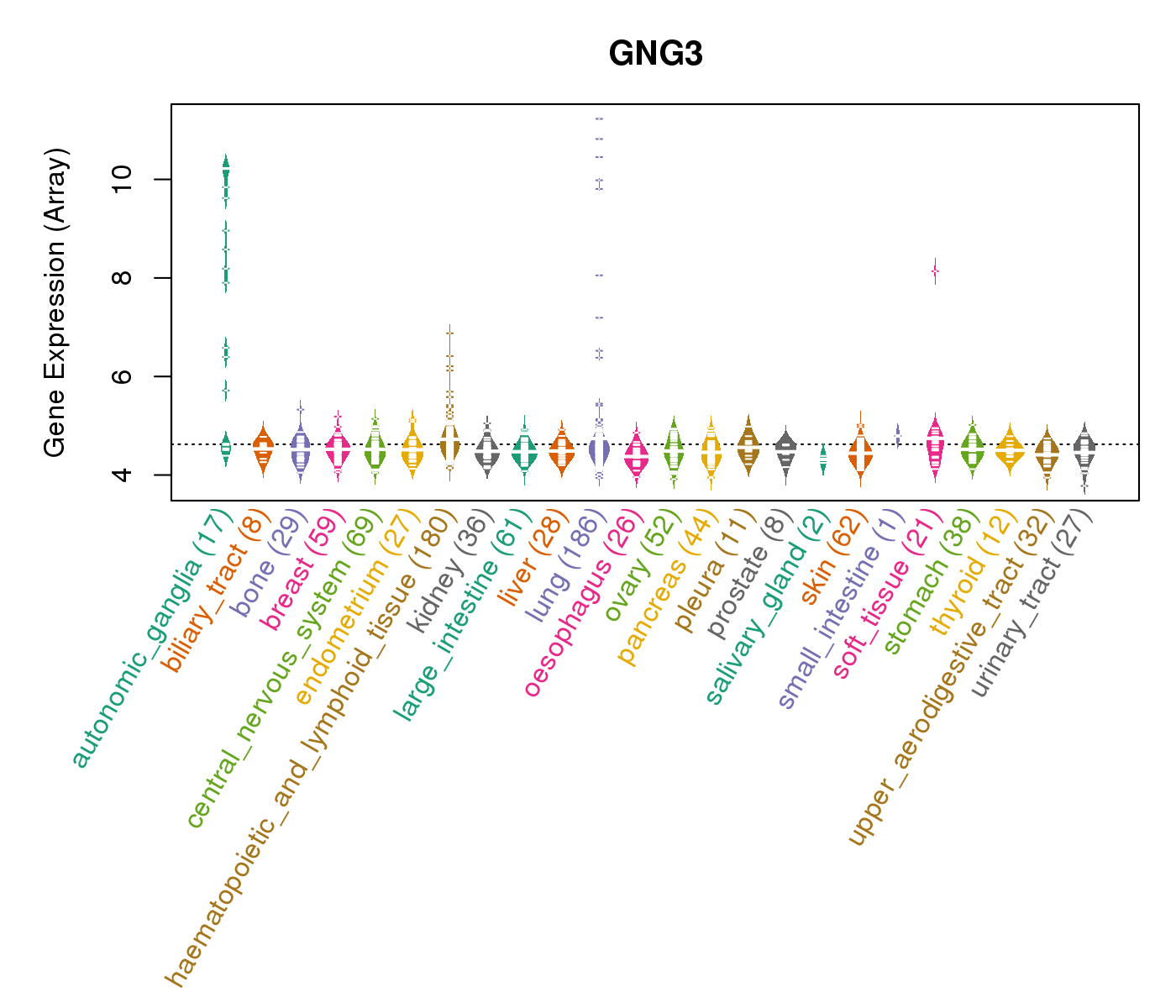 |
| * Normalized gene expression data of RNASeqV2 was extracted from TCGA using R package TCGA-Assembler. The URLs of all public data files on TCGA DCC data server were gathered at Jan-05-2015. Only eight cancer types have enough normal control samples for differential expression analysis. (t test, adjusted p<0.05 (using Benjamini-Hochberg FDR)) |
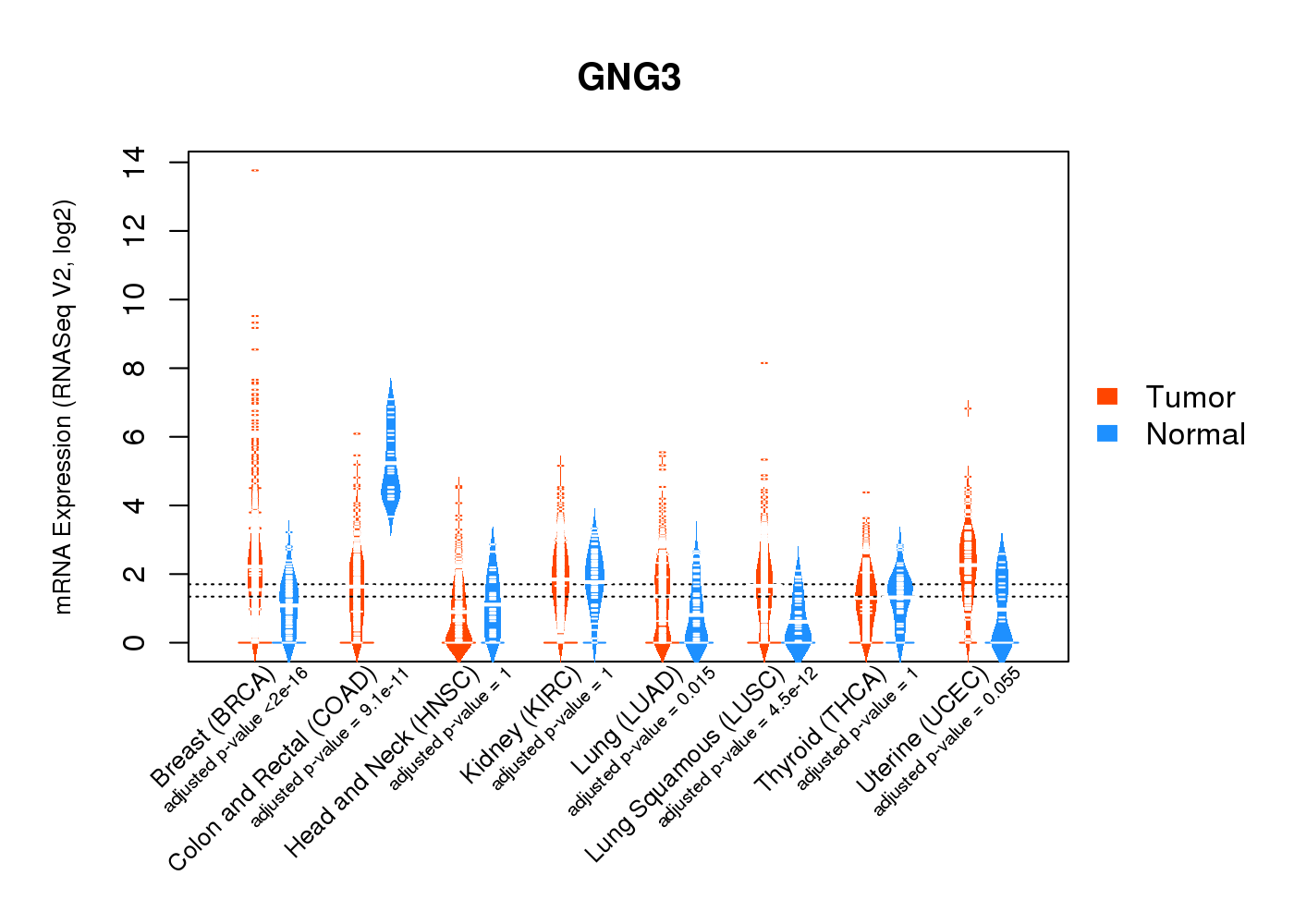 |
| Top |
| * This plots show the correlation between CNV and gene expression. |
: Open all plots for all cancer types
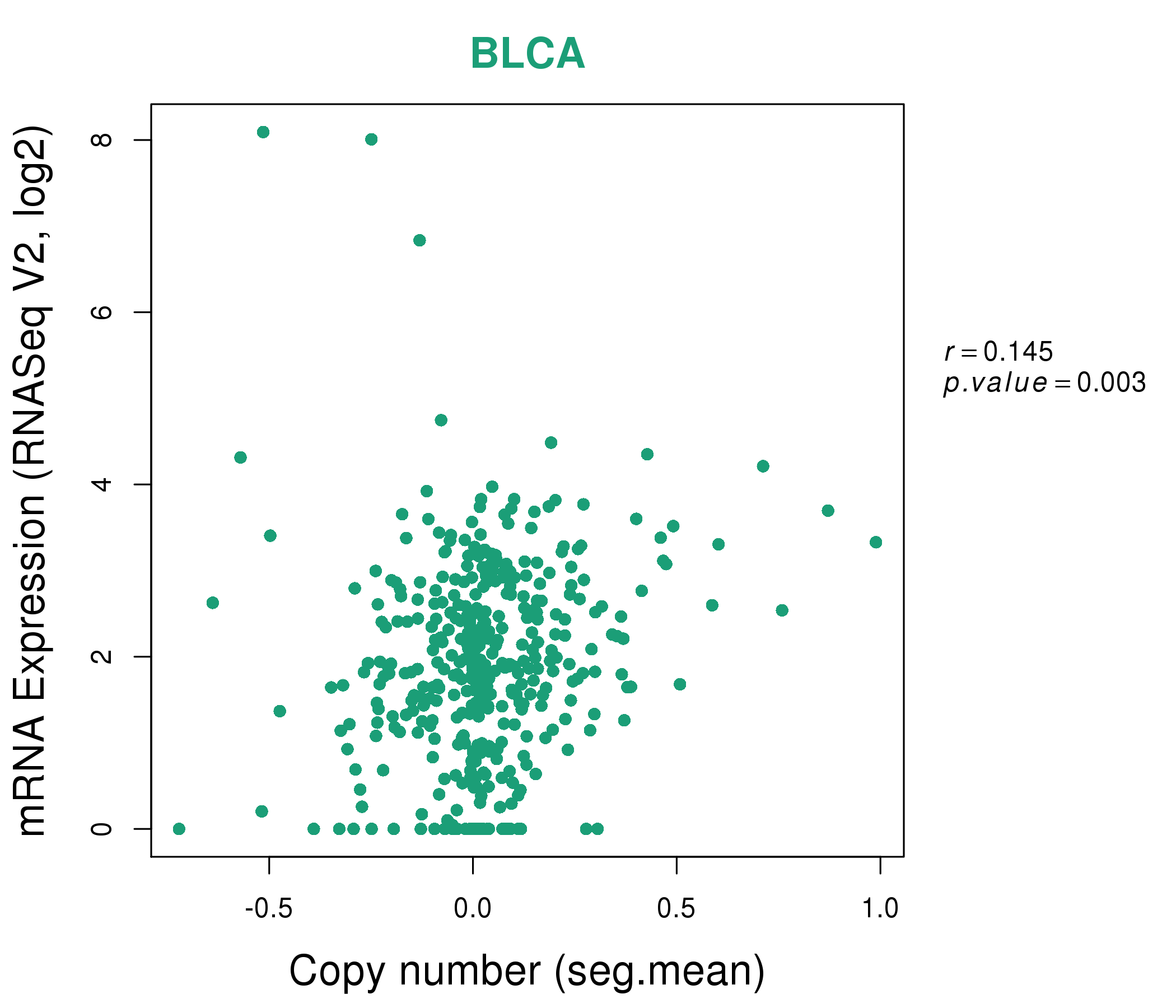 |
|
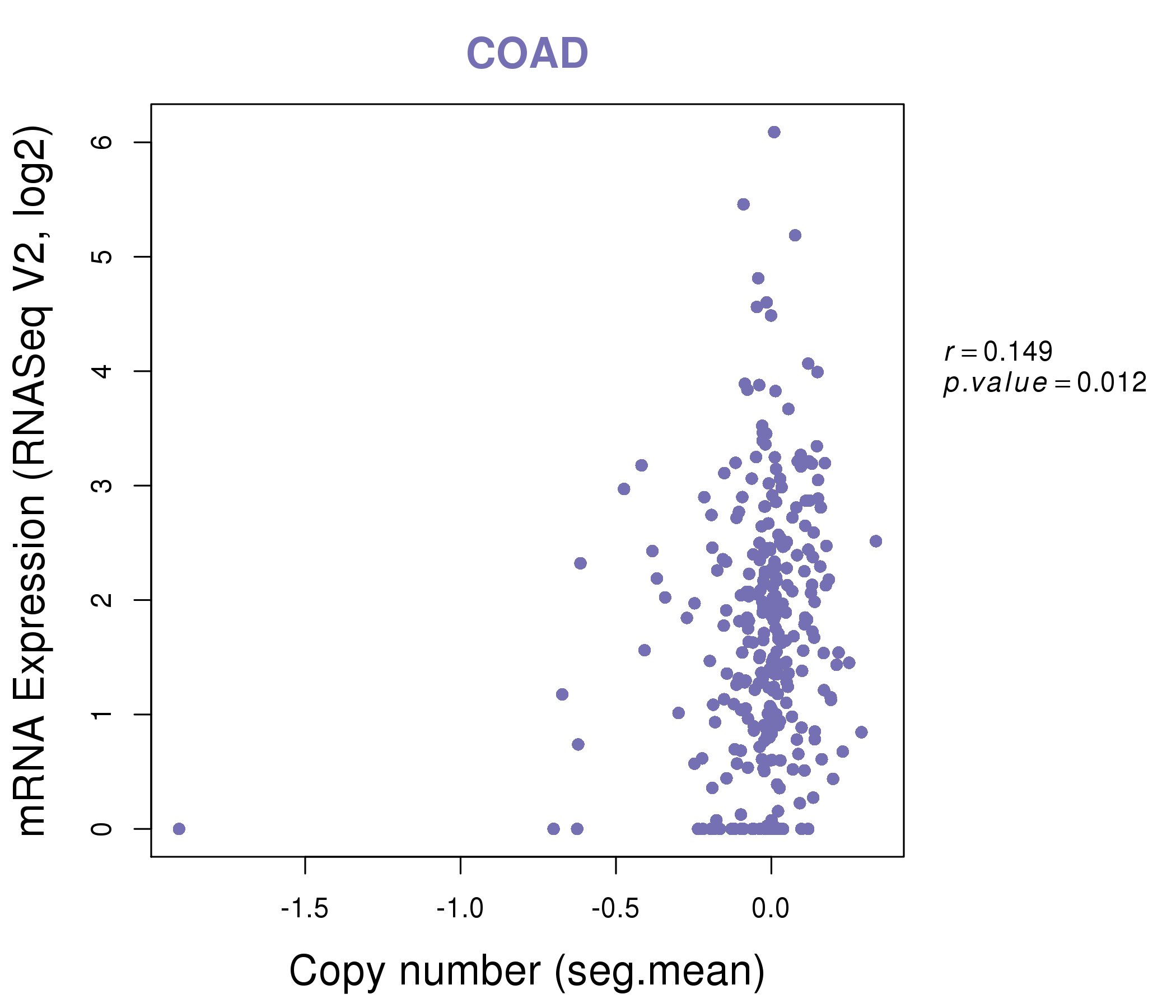 |
|
| Top |
| Gene-Gene Network Information |
| * Co-Expression network figures were drawn using R package igraph. Only the top 20 genes with the highest correlations were shown. Red circle: input gene, orange circle: cell metabolism gene, sky circle: other gene |
: Open all plots for all cancer types
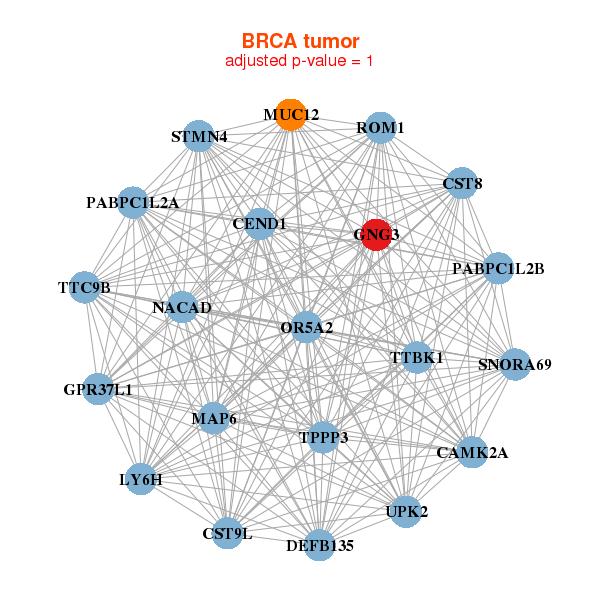 |
|
| CAMK2A,CEND1,CST8,CST9L,DEFB135,GNG3,GPR37L1, LY6H,MAP6,MUC12,NACAD,OR5A2,PABPC1L2A,PABPC1L2B, ROM1,SNORA69,STMN4,TPPP3,TTBK1,TTC9B,UPK2 | AHCY,ATP5G2,PTRHD1,EEF1B2,GNB2L1,GNG3,DANCR, NPRL2,RPL10A,RPL12,RPL13A,RPL41,RPLP0,RPLP1, RPS10,RPS24,RPS2,RPS4X,RPS7,RPSAP58,ZNHIT3 |
 |
|
| ARPP21,CDH19,CMTM5,DPP6,ELAVL3,GAP43,GNG3, NEFM,NGB,PHOX2A,PHOX2B,PLP1,PRIMA1,PRPH, SLC18A3,SLC5A7,SORCS1,SOX10,ST8SIA3,STMN4,SYT9 | APLP1,FNDC9,CALY,CELF4,CTNNA2,ELAVL4,GAP43, GNG3,HMP19,LRRC55,NDRG4,OLFM3,PHOX2B,PIRT, PRPH,PTPRN,RTN1,SLC10A4,SULT4A1,TMEM59L,UCHL1 |
| * Co-Expression network figures were drawn using R package igraph. Only the top 20 genes with the highest correlations were shown. Red circle: input gene, orange circle: cell metabolism gene, sky circle: other gene |
: Open all plots for all cancer types
| Top |
: Open all interacting genes' information including KEGG pathway for all interacting genes from DAVID
| Top |
| Pharmacological Information for GNG3 |
| There's no related Drug. |
| Top |
| Cross referenced IDs for GNG3 |
| * We obtained these cross-references from Uniprot database. It covers 150 different DBs, 18 categories. http://www.uniprot.org/help/cross_references_section |
: Open all cross reference information
|
Copyright © 2016-Present - The Univsersity of Texas Health Science Center at Houston @ |






